







You’re probably a macho guy (or a really cool chick) who knows football inside and out. But just to make sure we’re on the same page here, let’s run through some of the basic rules of football formations before we have a look at the formations themselves.
Offensive Positioning
There must be 11 total players. Of these, 6 positions are always the same. They are the five players make up the offensive line (OL)—1 center (C), 2 guards (G), 2 tackles (T)—plus 1 quarterback (QB).
The other 5 positions can be any combination of the remaining positions: 0-3 tight ends (TE), 0-5 wide receivers (WR), and 0-3 backs (FB/HB).
For any given play, there must be at least 7 players on the line of scrimmage—the 5 on the OL, plus at least 2 more. These two can be either TEs or WRs. A team can place more players on the line of scrimmage, but the rule is that only the two players on the ends are eligible receivers. So, most often, to maximize the number of eligible receivers, teams place the minimum 7 players up front, leaving 4 in the backfield.
These are the possibilities a coach has to work with when choosing how his team lines up on offense.
Defensive Positioning
Obviously, there are also 11 total players on the defensive side of the ball. However, unlike offensive formations, in the NFL there are no rules regulating where defensive players must be positioned (as long as they are on their side of the line of scrimmage). They can be in “the box,” which is just an area within 5 yards of the ball and the line of scrimmage, or in the “secondary,” which is anywhere else. And after the snap, any player can go anywhere and do anything. Thus, coaches have a lot of leeway in drawing up defensive formations.
Still, there are 3 basic types of defensive positions: defensive linemen (DL), who line up right across from the OL in the box; linebackers (LB), who are positioned behind the DL, but still in the box; and defensive backs (DB), who are positioned in the secondary.
Players on the DL are called defensive ends (DE) if they are on the ends of the line and defensive tackles (DT) if they are in the middle. Often, if there is an odd number of tackles (i.e., 1 or 3), the middle/only tackle lined up over the ball is called a nose tackle (NT).
LBs are either strong (SLB), middle (MLB), or weak (WLB), depending on where they are relative to the offensive formation—if a linebacker is lined up opposite the offensive team’s TE, he is the SLB.
Players in the secondary are either cornerbacks (CB), who cover WRs, or safeties, who defend against the run and pass. A player is a strong safety (SS) if lined up on the same side as a TE or a free safety (FS) if free to roam wherever he is needed.
Now, let’s look at 9 football formations every man should know.
9. I Formation (Offense)

The I formation is a “traditional” modern offensive formation that gets its name from the I-shaped alignment of the QB, FB and HB. Using 2 backs and, typically, 2 WRs and 1 TE, this formation is conducive to both running and passing plays. When the latter is chosen, the back without the ball—usually the FB—will block for the back with the ball. The I Formation isn’t all that common in the NFL today, as the pro set formation (#7 below) can accomplish pretty much the same thing. However, the I formation is still sometimes used for play-action passes or short yardage running situations.
8. 4-3 Defense
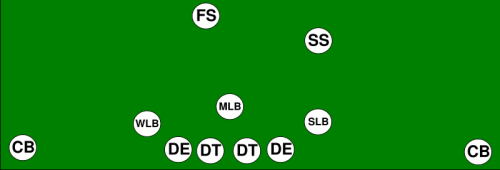
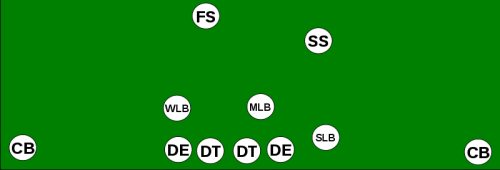
The 4-3 defense is the most common base defensive formation in the NFL. With 4 defensive linemen, 3 LBs, and 4 players in the secondary, it is just about as balanced a defensive alignment as there can be. It is also versatile in that LBs can shift to the strong or weak sides, depending on the type of play they anticipate from the offensive team.
7. Pro Set Formation (Offense)

The pro set formation is another “traditional” modern offensive formation. Like the I formation, the pro set is a balanced formation that usually features 2 backs, 2 WRs, and a TE. The main difference between the pro set and the I is simply that the two backs are on either side of the quarterback. Thus there is a bit of a tradeoff when using the pro set: you lose the blocking of the FB in the I formation, but you gain some uncertainty, as the defense doesn’t know which side of center the ball will go to.
6. 3-4 Defense
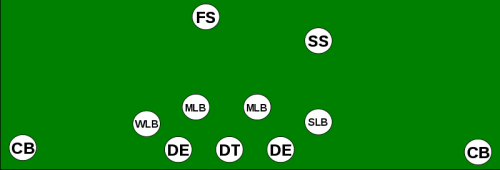
The 3-4 defense is the other basic defensive formation, along with the 4-3. The 3-4 basically takes one of the DLs away from the 4-3 and adds a fourth LB, still leaving 4 in the secondary. While the 4-3 is more common in the NFL today because it is often stronger against the run, teams with exceptionally quick LBs might choose the 3-4 because it can offer a bit more versatility.
5. Shotgun Formation (Offense)

You have a shotgun formation any time the QB lines up about 5 yards behind the center and receives a snap rather than a handoff from the C. Typically, this formation uses only 1 back with 3 WRs and 1 TE, although any variation of players in the backfield is possible. The advantage of the QB’s position on this formation is that he can see the defensive alignment more clearly and has more time to throw the ball. Teams with excellent QBs and an aggressive passing game—like Indianapolis and New England—have used the shotgun as their standard offensive formation in recent years.
4. Nickel Defense
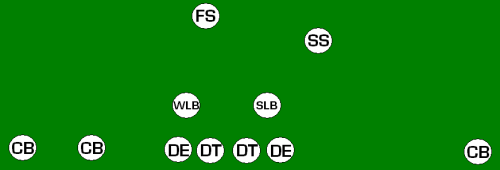
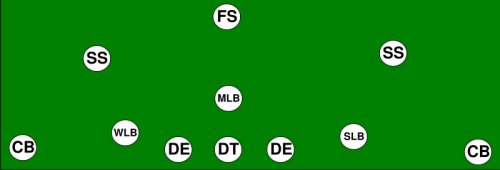
The nickel formation is any formation that has 5 players in the secondary instead of 4. (Get it? 5 cents in a nickel, 5 players in the secondary?) Basically, to better defend against a passing formation put in place by the offensive team, the defensive team sacrifices either a DL or a LB in favor of either an additional CB or safety. The additional defender is called a “nickelback.” The 4-2-5 nickel formation is like a 4-3 defense, only 1 LB becomes a third CB. On the other hand, the 3-5-3 nickel is like a 3-4 defense, only 1 LB becomes a third safety.
3. Spread Formation (Offense)

The spread formation is a particularly aggressive variant of the single set back formation (which is just like the standard shotgun formation, only the QB lines up immediately behind the C). Where the spread formation differs from the standard single set back is in its use of 4 WRs and 0 TEs. The idea is that this formation spreads out the defense, creating more space. Though typically used for passing plays, the spread formation can also occasionally creates big holes in the DL for effective runs. Also, it’s more common in college than the NFL.
2. Dime Defense
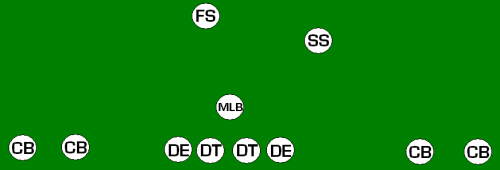
The dime defense is typically used against the most aggressive offensive passing formations. Whereas the nickel defense adds 1 more defender to the secondary (called a nickelback), the dime defense adds 2, bringing the grand total to 6. Just as two nickels equals one dime, two nickelbacks make a dime formation. Most often, what this all adds up to is 4 DLs, 1 LB, 4 CBs, and 2 safeties. But theoretically you there could be 3 DLs, 2 LBs, 3 CBs and 3 safeties. All that matters is that there are 6 in the secondary to defend against desperation passing plays.
1. Goal Line Formation (Offense/Defense)
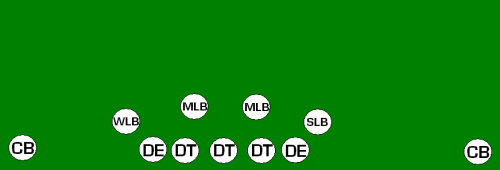
The offensive and defensive versions of the goal line formation are basically the same: when the ball is within a few yards of the end zone, both teams will forget about the secondary and cram the box with as many bodies as possible. Offensively, this means 0 WRs with 3 TEs and 2 backs (plus the 5-man OL and the QB, making 11). Defensively, this means 0 safeties with a 5-man DL, 4 LBs and 2 CBs.


미국축구 동호인 은 5000만명이 넘습니다
한나라안에 이렇게 큰 동호인 모임은 미국만입니다.
과학분야만 아니고 여러가지 sports 도 100년전에 발명해 내서 즐기고 있습니다
중국 인도 는 인구는 많아도 Organized Sport 는 없습니다.
100-200년전에는 새로은 것에 대한 연구/창조 -- 동양 서양 많이 달랐습니다
웹사이트에 이상한 현상 발생
오랜만에 들어보는 턴테이블
Ripple =46mv 350v -90W B 전원
350v -90W B 전원
LP 애호가들 LP 를CD 로 전환
Transformer Ringing
B 전원 설계 II - KDK 식
MC cartridge Step- up Trans
Spot welder For R-core
B 전원 설계 - KDK 식
B 전원 - 무식에서 벗어나자 !!!
Football and Me
How to make a tone arm
Turn Table - How to make
Bristol show Turntable 2016 &2017 - 영국 영어 + 미국영어
Baby Dynaco - ST35 -- 새로 정리
기초지식 - Batteries & Capacitors - 인도영어 4분
Simple Idea
Turntable - 自作
새로쓴 - 300B 이야기
진공관 高級知識
미국에는 원체 축구광들이 많아서 정상으로 봐 줍니다.
여기 Reno는 도박이 합법인 도박도시입니다. 고층 큰 Casino-도박장 만도 10곳정도 있습니다.
Sports Book -Betting- 많이들 합니다. 돈을 걸게되면 응원도 열심히 하게 됩니다
축구를 배우겠다는 분이 계셔서 보는법을 아래에 올렸습니다